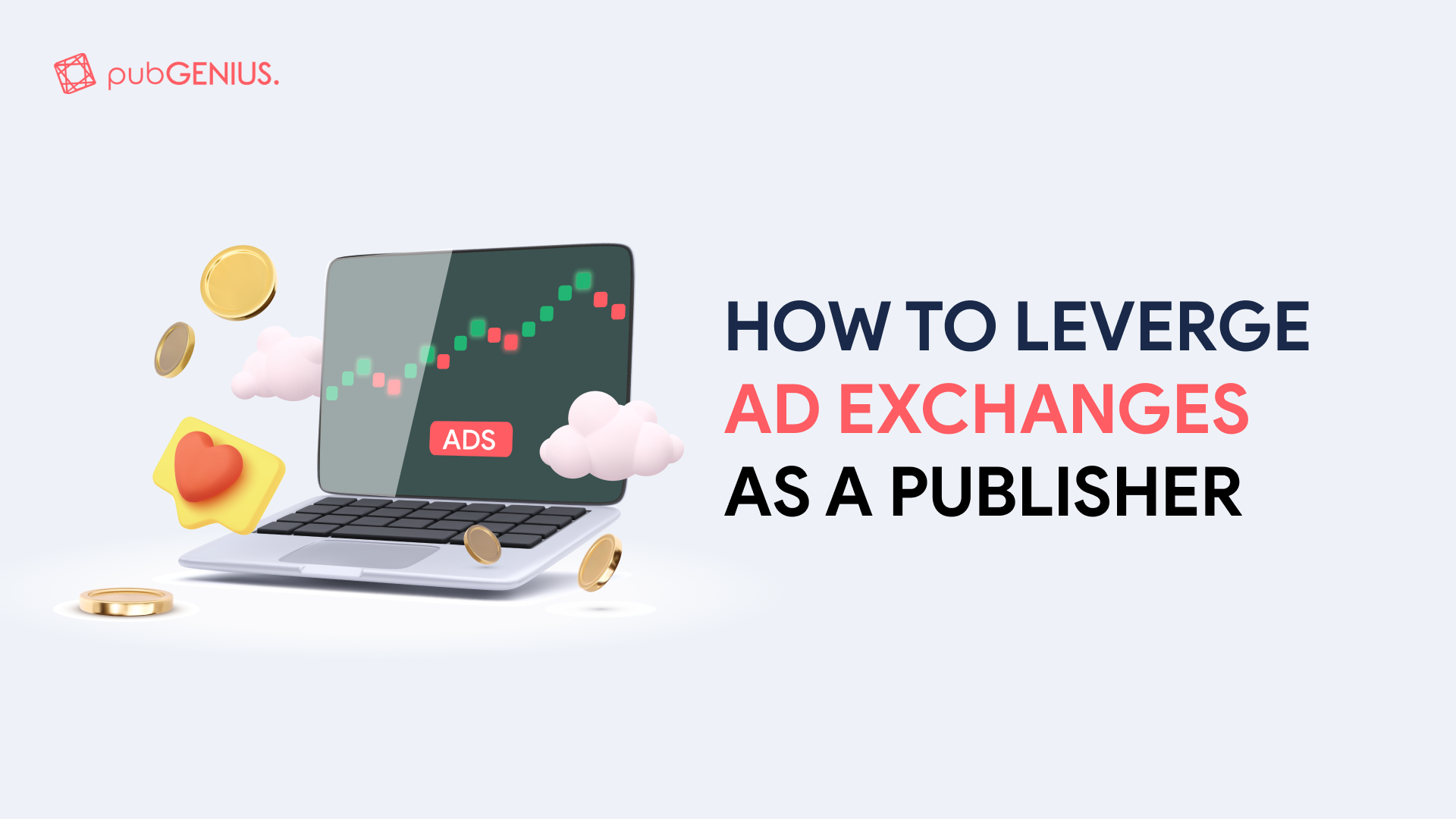Leveraging Ad Exchanges as a Publisher
January 18, 2022
Today, ad exchanges are probably the most popular way for publishers, smaller ones especially, to find suitable advertisers for their ad inventory. According to Datanyze, more than 300,000 companies across the globe are using ad exchanges in 2021. They are also one of the main drivers of programmatically-sold advertising market growth, which is estimated to reach $155 bln in 2021 just in the United States alone.
As we’ve been doing our best to provide useful and actionable information on various components of the ad stack, such as Demand-Side Platforms (DSPs) and Supply-Side Platforms (SSPs), we thought now is a good time to talk more about ad exchanges. And the way you can get maximum benefit from using these platforms as a publisher.
What is an ad exchange?
Just to make sure we are all on the same page, let’s quickly go through some basics.
Ad exchanges are online platforms that bring publishers and advertisers together by providing a technology-driven marketplace to help parties buy and sell ad inventory with maximum efficiency. Ad exchanges usually include various types of advertising inventory, such as display, mobile, video, in-app ads and other. They can also specialize in certain types of ads only.
The process of buying and selling ads is typically facilitated with real-time bidding (RTB) technology.
-
What’s the difference between ad exchanges and ad networks?
As ad networks and ad exchanges play a very similar role in the digital advertising space, it is not uncommon for these two types of ad tech stack to be confused with each other.
Ad networks aggregate ad spaces from various publishers on their platforms and sell them to ad buyers for a commission. Ad exchanges serve the same goal, aggregating ad inventories from multiple publishers and offering them to advertisers and ad buyers. The difference, however, is that ad exchanges enable publishers and advertisers to trade directly by enabling transparent prices for impressions with RTB technology. Ad exchanges can include ad inventory from multiple ad networks as well as other sources, thus providing a wider choice of ad inventories available for sale.
-
What are the most popular ad exchanges?
Finalising the general information, let’s mention some of the most popular ad exchanges available to publishers and advertisers in 2021.
- Google Ad Manager (ex-DoubleClick), which is the biggest ad exchange in the world with almost 50% of the global market,
- OpenX,
- AppNexus,
- Rubicon Project,
- Verizon Media,
- PubMatic,
- Bid Switch,
- Baidu Exchange,
- Bid Switch.
How to choose an ad exchange?
Choosing the ad exchange that is a good fit for your specific needs and requirements can be tricky, so it makes sense to talk about this in more detail.
Here are some of the most important criteria to pay attention to when choosing an ad exchange.
-
Support of ad types and formats.
Starting at a more obvious point, you need to make sure the ad exchange fully supports the types and formats of ads that make up your ad inventory. The support of a wide range of different ad types allows you to have a better choice and flexibility in terms of adjusting your inventory to maximize revenues.
-
Traffic quality control capabilities.
As ad exchanges are typically dealing with enormous volumes of traffic, invalid traffic and ad fraud can be a problem. This is why anti-fraud capabilities are an important factor to consider when choosing an ad exchange. A good ad exchange needs to have a set of validation and traffic optimization tools, allowing you to quickly detect invalid traffic and other suspicious activity.
-
Support of connection protocols and third-party integration.
It is desirable for an ad exchange to support multiple connection protocols, including XML, JSON, and oRTB, as well as to provide third-party integration capabilities for better flexibility and transparency.
-
IAB standards support.
The support of IAB (Interactive Advertising Bureau) standards is something many advertisers are looking for in ad platforms they are using to buy ads. And the majority of big ad exchanges have it. IAB introduced ads.txt file that allows publishers to list their authorized sellers and resellers, signaling to buyers which supply paths to the publisher’s inventory are legitimate, several years ago.
-
Inventory optimization tools and analytics.
Another aspect to look at is which optimization and analytical tools an ad exchange has to offer to a publisher. Powerful ad platforms include instruments that allow you to analyze bidding patterns of advertisers and multiple other aspects of RTB auctions, as well as to access real-time statistics and performance reports.
-
Traffic intelligence capabilities.
Many publishers don’t have powerful user data collection capabilities, which results in them lacking data in their bid requests. This is why it is important to choose an ad exchange that has device, IP and other types of audience intelligence capabilities, which would allow it to complement publisher’s bid requests with its own data when it is necessary.
How to leverage ad exchange as a publisher?
As a final piece of information, we would like to specify several main ways for publishers to leverage an ad exchange for the maximum benefit.
-
Ad filtering, blacklisting and whitelisting.
The ability to easily filter ads and blacklist advertising partners to avoid undesirable content is one reason why publishers use ad exchanges.
-
Targeting options.
As we mentioned earlier, solid ad exchanges provide publishers with various kinds of audience intelligence capabilities, allowing them to reach advertisers who are looking for highly targeted ad placements.
-
Establishing a fair price for your ad inventory.
Ad exchanges allow publishers to set minimum CPMs for their ad impressions to determine a fair market price via RTB auctions.
-
Ad placement customization options.
Publishers also typically have a selection of options allowing them to customize ads that are coming from ad exchanges, changing fonts, colors and other style elements in order for the ads to match their websites better.
-
Data analytics and insights.
Utilizing ad exchanges is also a great way to collect multiple kinds of analytical data. Which then can be used to optimize your ad inventory and adjust the monetization strategy overall.
Summary
Publishers have been relying on ad exchanges for years, and they continue to play a vitally important role in the programmatic advertising ecosystem. Even though new trending technologies, such as private marketplaces, are taking some clients away. Ad exchanges provide advertisers with a lot of control over the process of selling their ad inventory, as well making it transparent. So it is desirable to have at least a couple of ad exchanges in your ad stack as a publisher to achieve the best ad inventory performance.
Don’t have time and energy to look for the ad exchange that will be the right match for your ad inventory? Allow professionals with proven expertise in digital publishing to take care of this.
This is us! The pubGENIUS team consists of highly experienced specialists who are well-versed in the best practices and trends of the industry. We know how to utilize innovative technologies and ad formats to optimize websites for individual publishers. We will make sure that your websites are using the most relevant tools and your ad inventory is set up and operating with maximum capacity at all times.
Get in touch with pubGENIUS Team to get free consultation 🙂
